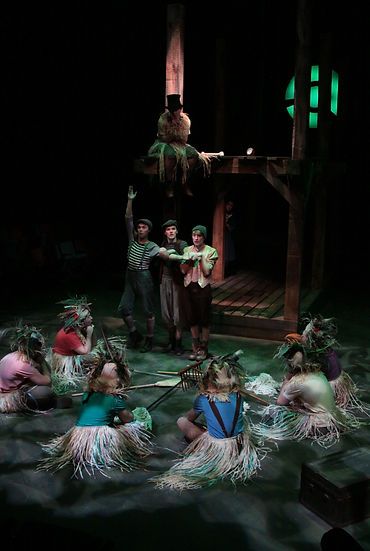Peter and the Starcatcher
Properties Master
Directed by: Paul J. Hustoles
Scene Design: Ben Kramer
Costume Design: David McCarl
Lighting design: Steve Smith
Sound Design: George Grubb
Paint Charge: Alex Rollins
Technical Director: George Grubb

Our concept for Peter and the Starcatcher, and our main challenge in design, was making the show appear as if told by children playing a game together. It would all take place in an attic and everything they used in their game had to be something they could have easily gotten their hands on. as the props master, I had to be clever in which items I chose to represent what the script called for.

For example: the character Ted finds a pineapple early in Act 2. Now, orphaned children in Victorian England probably wouldn't have access to pineapples so easily. Instead, we dressed up a partially deflated rugby ball with a feather and indented the bottom and viola! A pineapple is what the children believed they were playing with.
There are a couple different places in the script where it calls for weapons such as swords ans spears. There was no way putting actual metal weapons into the hands of children was going to fit with out concept. So instead, we supplied them with brooms, rakes, pool cues, and other wooden poles that one might have stuffed into their attic.
Getting these to the actors quickly was essential in prepping them for fight choreography with unbalanced weapons.



The iconic Neverland sign lets the audience know that this story is actually about Peter Pan. In this scene, the two lovebirds are floating on the wreckage of the ship, so the sign had to be legible but worn. I pained the lettering on first then destroyed the wood around it to create some wear and tear around the edges.
Mr. Grin! the fearsome crocodile that lives on the island the children are trapped on. The best thing I found to create the croc was an old alligator skin chest. creating the visage of chomping teeth came easy to the actors with basically a giant mouth as a prop.

Mr Grin has LED lights affixed to the front of the chest that would turn on with a light tap from the actors. This created the glowing eyes effect.


To create the model ships, I assembled some 3-D puzzles and painted them to look more realistic. Both were fortified with extra wood pieces for bracing and hot glue to firmly attach all the parts together.
One ship (left) had to be able to split in half as part of the script. I used a band saw to first cut it, then installed magnets inside so the ship could stay together for most of the show while waiting for the big moment.


How else would a child make a cat fly? By attaching it to a stick and running of course!
The Jolly Roger is synonymous with pirates everywhere. this one had to look like it was made by children an easily hidden in an actor's coat.
